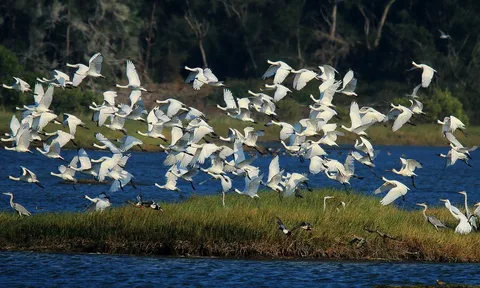Introduction
Ever wondered what wetlands and woodwinds might share in common?
At first glance, these two elements seem worlds apart. One is a vital natural habitat, while the other is a family of musical instruments.
But look closer, and you’ll find fascinating connections between them.
Let’s dive into their similarities and differences, and uncover why understanding both can enrich our appreciation of the world around us.
Understanding Wetlands
Definition and Types
Wetlands are unique ecosystems where water meets the land. They include marshes, swamps, bogs, and estuaries.
Each type supports different kinds of plants and animals, and they all play crucial roles in our environment.
Importance in Ecosystems
Wetlands are natural water filters. They trap pollutants, reduce flooding, and recharge groundwater.
Their ability to purify water makes them indispensable for maintaining clean and healthy ecosystems.
Examples of Wetlands
Consider the Everglades in Florida. This massive wetland is home to a diverse array of species, from alligators to wading birds.
In Brazil, the Pantanal is one of the largest tropical wetlands in the world, teeming with wildlife and supporting a complex web of life.
Exploring Woodwinds
Definition and Types
Woodwind instruments produce sound by blowing air through a reed or across an opening.
This category includes flutes, clarinets, oboes, and bassoons.
Each instrument has a distinct sound and technique, contributing to a rich tapestry of musical expression.
Role in Music
Woodwinds add depth and colour to musical compositions.
They can produce a range of sounds from the bright, piercing notes of a piccolo to the warm, mellow tones of a bassoon.
Their versatility allows them to shine in orchestras, bands, and solo performances.
Examples of Woodwind Instruments
The piccolo is a smaller, higher-pitched flute, often used for bright, shining melodies.
The clarinet, with its smooth, versatile sound, is a staple in many musical ensembles.
The oboe’s distinctive, reedy tone makes it a key player in orchestral settings, while the bassoon provides rich, lower tones.
Common Features of Wetlands and Woodwinds
Acoustic Qualities
Both wetlands and woodwinds are connected through sound.
Wetlands create natural soundscapes where birds chirp, water flows, and amphibians croak.
Woodwinds generate musical tones that can evoke a wide range of emotions, from joy to melancholy.
Connection to Nature
Wetlands are deeply intertwined with nature, supporting a myriad of life forms and maintaining ecological balance.
Woodwind instruments, while man-made, often mimic natural sounds and are inspired by the rhythms and tones of the natural world.
Environmental Impact
Wetlands have a profound impact on their environment by regulating water levels, providing habitat, and enhancing biodiversity.
Woodwinds impact us emotionally and culturally, bringing people together through music and enhancing our appreciation for artistic expression.
Differences Between Wetlands and Woodwinds
Functional Differences
Wetlands serve as crucial ecological systems, offering services like water filtration and flood control.
Woodwinds, in contrast, serve as tools for musical expression, adding beauty and complexity to our auditory experiences.
Impact on Surroundings
Wetlands affect their surroundings by supporting wildlife and improving environmental health.
Woodwinds influence us through their music, which can inspire, comfort, or entertain.
Interaction with Humans
Humans interact with wetlands through activities such as conservation efforts and recreational visits.
We engage with woodwinds by learning to play, attending performances, or simply enjoying their sound in various musical settings.
Why We Should Care
Preservation of Wetlands
Protecting wetlands is essential for preserving biodiversity and maintaining ecological health.
Efforts to conserve these areas ensure that they continue to provide critical environmental benefits.
Importance of Woodwind Music
Woodwind music enriches our cultural landscape.
It offers emotional depth, creative expression, and a connection to artistic traditions. Supporting musicians and music education helps keep this tradition vibrant.
Benefits to Society
Both wetlands and woodwinds enhance our quality of life in different ways.
Wetlands improve environmental conditions and support diverse ecosystems, while woodwinds bring joy and inspiration through music.
Conclusion
While wetlands and woodwinds may seem disparate, they share intriguing similarities.
Wetlands support life and maintain ecological balance, while woodwinds bring musical richness and emotional depth to our lives.
By understanding and appreciating both, we gain a greater appreciation for the interconnectedness of our world and the diverse ways it can enrich our lives.
FAQs
What makes wetlands unique compared to other ecosystems?
Wetlands are unique due to their water-saturated conditions, which support a specific range of flora and fauna. They play essential roles in water filtration, flood control, and maintaining biodiversity.
How do woodwind instruments contribute to music?
Woodwind instruments offer a wide range of sounds and timbres, adding texture and depth to music. They are versatile and can evoke various emotions, making them crucial in both orchestral and solo performances.
Can wetlands and woodwinds impact each other?
While they operate in different realms, wetlands and woodwinds can influence each other indirectly. For instance, the natural sounds of wetlands might inspire woodwind compositions, and appreciation of woodwind music can raise awareness about environmental issues.
Why is it important to preserve wetlands?
Preserving wetlands is vital for environmental health. They provide critical services such as water filtration, flood control, and habitat for diverse species, making them essential for maintaining ecological balance.
How can one start learning to play a woodwind instrument?
To start learning a woodwind instrument, seek out a skilled teacher or online resources. Practice regularly, join a group or ensemble, and immerse yourself in the music to develop your skills and enjoyment.

